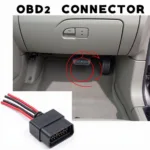New York State mandates regular vehicle inspections to ensure road safety and minimize environmental impact. A crucial part of this inspection involves the OBD2 system, a sophisticated computer network that monitors your car’s emissions and performance. This article will guide you through everything you need to know about the NYS OBD2 inspection, empowering you to confidently approach your next check-up.
What is an OBD2 Inspection?
The acronym OBD2 stands for On-Board Diagnostics, Generation Two. It refers to the standardized system used in vehicles manufactured after 1996 to monitor and report on the performance of major engine and emission control systems. During an OBD2 inspection, a certified technician connects a scan tool to your car’s OBD2 port, typically located under the dashboard on the driver’s side.
The scan tool retrieves data from your car’s computer, checking for any stored trouble codes. These codes act as indicators, signaling potential issues within your vehicle’s systems.
Why is the OBD2 Inspection Important?
The OBD2 inspection plays a vital role in identifying emissions-related problems that can contribute to air pollution. By detecting and addressing these issues early on, we collectively contribute to a healthier environment and cleaner air quality.
Moreover, the inspection serves as a preventative measure. It can reveal underlying mechanical problems that may not be immediately noticeable, preventing potential breakdowns and costly repairs down the line. Think of it as a health check-up for your car, ensuring it runs smoothly and safely.
What Happens During an NYS OBD2 Inspection?
- Connection and Data Retrieval: The technician connects the scan tool to your vehicle’s OBD2 port, retrieving stored diagnostic trouble codes and freeze frame data.
- Code Interpretation: Each code corresponds to a specific issue within the engine or emissions system. The technician analyzes these codes to determine the root cause of any potential problems.
- Visual Inspection: Alongside the scan tool diagnostics, the technician visually inspects components like the gas cap, exhaust system, and check engine light functionality.
- Result Determination: Based on the retrieved data and visual inspection, the technician determines if your vehicle passes or fails the OBD2 portion of the inspection.
What Causes an OBD2 Inspection Failure?
Several factors can trigger an OBD2 inspection failure:
- Illuminated Check Engine Light: A lit check engine light indicates a problem detected by your car’s OBD2 system.
- Stored Trouble Codes: Even if your check engine light isn’t currently on, stored codes indicate a past issue that might still need attention.
- Missing or Damaged Gas Cap: A faulty gas cap can lead to fuel vapor leaks, negatively impacting emissions.
- Malfunctioning Emissions Components: Issues with components like the catalytic converter, oxygen sensors, or evaporative emissions system can also cause failures.
What to Do if Your Vehicle Fails
If your car fails the OBD2 inspection, don’t panic. The technician will provide you with a report outlining the specific reasons for the failure. You’ll typically have a limited time frame to address the issues and return for a re-inspection.
Expert Insight:
“Many car owners make the mistake of ignoring their check engine light,” says John Smith, a certified master mechanic with over 20 years of experience. “This light is your car’s way of telling you something is wrong. Addressing the issue promptly can save you time, money, and potential headaches down the road.”
Tips to Prepare for Your NYS OBD2 Inspection
Follow these simple tips to increase your chances of passing:
- Address Check Engine Light: If your check engine light is on, get it diagnosed and repaired by a qualified mechanic before the inspection.
- Regular Maintenance: Follow your car manufacturer’s recommended maintenance schedule, including oil changes, spark plug replacements, and air filter inspections.
- Check Your Gas Cap: Ensure your gas cap is properly tightened and free of any cracks or damage.
- Drive Your Car: Take your car for a decent drive before the inspection, especially if it’s been sitting idle for a while. This allows the OBD2 system to gather sufficient data.
Conclusion
The NYS OBD2 inspection is a crucial part of vehicle maintenance, promoting both environmental protection and road safety. By understanding the inspection process, potential causes for failure, and preparation tips, you can approach your next inspection with confidence. Remember, a well-maintained vehicle is a safer vehicle, both for you and the environment.
FAQs
1. How often do I need to get an OBD2 inspection in NYS?
New York State requires annual vehicle inspections, which include the OBD2 check.
2. Will disconnecting my battery reset the OBD2 system and help me pass?
While disconnecting the battery might temporarily clear the check engine light and some codes, it won’t solve the underlying problem. The inspection equipment can often detect recent code erasures, potentially leading to further investigation.
3. Can I perform the OBD2 inspection myself?
While you can purchase OBD2 scanners for personal use, the NYS inspection must be conducted by a certified inspector at a licensed inspection station.
4. What happens if I don’t get my vehicle inspected?
Driving without a valid inspection sticker can result in fines, penalties, and even vehicle registration suspension.
5. Where can I find a certified NYS inspection station near me?
The New York State Department of Motor Vehicles website provides a convenient online tool to locate licensed inspection stations in your area.
For more information on OBD2 scanners and related topics, explore our comprehensive resources on OBDFree. Our team is dedicated to providing you with the knowledge and tools you need to make informed decisions about your vehicle’s health and performance.
Need Assistance? Contact our 24/7 customer support via WhatsApp: +1(641)206-8880, Email: [email protected].


